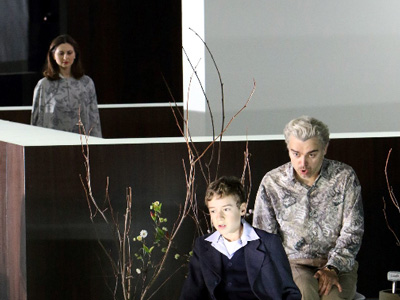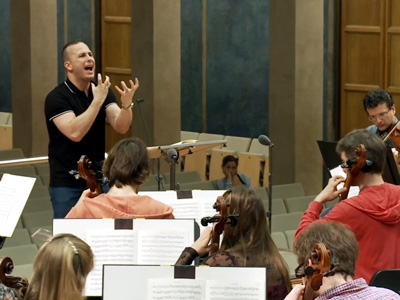By Sedgwick Clark
NOT TO BE MISSED! This week, the Metropolitan Opera pays tribute to the late Jon Vickers by devoting its entire programming on Sirius XM to archival broadcasts featuring the great Canadian tenor. The second opera I ever heard live was this Peter Grimes, and I was fortunate to attend at least one performance of every Met production in which he appeared thereafter.
Once heard, never forgotten. Looking over the repertoire list in the Met’s press release below, I realize how Vickers’s inimitable singing style, intensity, and commitment—especially as Florestan, Grimes, and Otello—colored my expectations whenever I heard another artist in the role.
Vickers made his Met debut as Canio in Pagliacci in 1960 and appeared in the opera for the last time 25 years later. I’ll never forget the scene where Canio frantically pursues his wife’s young lover, Silvio. The 59-year-old Vickers tore downstage like a man unhinged—not for a second allowing his age to compromise the dramatic moment.
Will Crutchfield provided an insightful summation of the tenor’s artistry in his Pagliacci review in the Times (11/25/85): “Mr. Vickers is utterly committed to the truth of each moment as it goes by, and . . . the strength of spirit and personal magnetism he brings to that commitment is enormous. In ‘Un tal gioco’ he was addressing the villager whose joke had touched a raw nerve, fixing him in the eyes. The man seemed a little shaken, as though it were real—just as, at the end, the Met choristers seemed really to be on the edge of their seats, watching Vickers-Canio step over the border between theater and life.”
New York, NY (July 17, 2015)— The Metropolitan Opera on Sirius XM (Channel 74) will honor the memory of the late Canadian tenor Jon Vickers, who passed away last week, by playing seven of his greatest Met performances in rotation throughout the week of July 20. The legendary dramatic tenor gave 280 Met performances during his career with the company, which spanned 27 years and included 17 different roles.
The company will honor Vickers in other ways throughout the coming season, including dedicating the opening night performance of Verdi’s Otello on September 21 to his memory.
The archival broadcasts that will air in rotation next week cover the full span of Vickers’s Met career, from 1960 to 1987. The performances include a 1960 matinee of Beethoven’s Fidelio, conducted by Karl Böhm and also starring Birgit Nilsson; a 1961 performance of Wagner’s Die Walküre, in which Vickers sang his most frequent Met role, Siegmund, opposite Nilsson and Gladys Kuchta, conducted by Erich Leinsdorf; performances of two of the title roles with which he was most identified, Britten’s Peter Grimes (from 1969) and Verdi’s Otello (from 1978); a rare comic role, Vašek in a 1978 performance of Smetana’s The Bartered Bride; a 1979 performance of Wagner’s Parsifal, also starring Christa Ludwig and conducted by James Levine in one of his first Met performances of the opera; and Vickers’s final Met performance, the April 18, 1987 matinee of Saint-Saëns’s Samson et Dalila, also starring Marilyn Horne.
More details on the seven performances, each of which will air 3 or 4 times during the week, is available below. For a complete schedule with broadcast times, please visit http://metopera.org/Season/Radio/Sirius-XM/.
Metropolitan Opera Radio on Sirius XM
Jon Vickers Tribute: July 20-26
Fidelio (February 13, 1960). Conductor: Karl Böhm. Starring: Birgit Nilsson, Jon Vickers, Hermann Uhde, Oskar Czerwenka, Laurel Hurley, Charles Anthony, Giorgio Tozzi
Die Walküre (December 23, 1961). Conductor: Erich Leinsdorf. Starring: Birgit Nilsson, Jon Vickers, Gladys Kuchta, Otto Edelmann, Irene Dalis, Ernst Wiemann.
Peter Grimes (April 5, 1969). Conductor: Colin Davis. Starring: Jon Vickers, Lucine Amara, Geraint Evans.
Otello (February 4, 1978). Conductor: James Levine. Starring: Jon Vickers, Katia Ricciarelli, Cornell MacNeil, Frank Little, James Morris.
The Bartered Bride (December 2, 1978). Conductor: James Levine. Starring: Teresa Stratas, Nicolai Gedda, Jon Vickers, Martti Talvela.
Parsifal (April 14, 1979). Conductor: James Levine. Starring: Christa Ludwig, Jon Vickers, Bernd Weikl, Martti Talvela, Vern Shinall.
Samson et Dalila (April 18, 1987). Conductor: Jean Fournet. Starring: Jon Vickers, Marilyn Horne, Louis Quilico.
 Haimovitz made his debut in 1984, at the age of 13, as soloist with Zubin Mehta and the Israel Philharmonic. At 17 he made his first recording with James Levine and the Chicago Symphony Orchestra, for Deutsche Grammophon. Haimovitz has since gone on to perform on the world’s most esteemed stages, with such orchestras and conductors as the Berlin Philharmonic with Levine, the New York Philharmonic with Mehta, the English Chamber Orchestra with Daniel Barenboim, the Boston Symphony Orchestra with Leonard Slatkin and the Montreal Symphony Orchestra with Kent Nagano. Haimovitz made his Carnegie Hall debut when he substituted for his teacher, the legendary Leonard Rose, in Schubert’s String Quintet in C, alongside Isaac Stern, Shlomo Mintz, Pinchas Zukerman and Mstislav Rostropovich.
Haimovitz made his debut in 1984, at the age of 13, as soloist with Zubin Mehta and the Israel Philharmonic. At 17 he made his first recording with James Levine and the Chicago Symphony Orchestra, for Deutsche Grammophon. Haimovitz has since gone on to perform on the world’s most esteemed stages, with such orchestras and conductors as the Berlin Philharmonic with Levine, the New York Philharmonic with Mehta, the English Chamber Orchestra with Daniel Barenboim, the Boston Symphony Orchestra with Leonard Slatkin and the Montreal Symphony Orchestra with Kent Nagano. Haimovitz made his Carnegie Hall debut when he substituted for his teacher, the legendary Leonard Rose, in Schubert’s String Quintet in C, alongside Isaac Stern, Shlomo Mintz, Pinchas Zukerman and Mstislav Rostropovich.



Petrenko to Extend in Munich
July 24th, 2015By ANDREW POWELL
Published: July 24, 2015
MUNICH — Bavarian State Opera has confirmed by phone it will announce a contract extension for Kirill Petrenko before the start of next season, in September. With the month of August being a house holiday, the news could come as early as next week when the company’s annual Munich Opera Festival winds down.
Petrenko, 43, became Generalmusikdirektor less than two years ago but has quickly earned respect with his musical dedication, technical gifts and impassioned manner. His present contract expires in August 2018.
Although talks to retain the Russian-Austrian’s services longer into the future have been underway for some time, as company Intendant Nikolaus Bachler noted last month, the announcement will be coming at an awkward juncture given Petrenko’s June 21 acceptance of a surprise invitation to serve as Chefdirigent of the Berlin Philharmonic, albeit with no firm start date.
His move from Carlos Kleiber’s orchestra to Herbert von Karajan’s will likely mean a briefer extension than would otherwise have been the case and a phasing in of Berlin commitments that works around his long-range Munich opera plans. Hopes are dashed anyway of a full Petrenko “era” at Bavarian State Opera like that of Wolfgang Sawallisch, who led the company for twenty-one years.
The new contract will have three parties: the conductor, who is currently preparing cycles of Der Ring des Nibelungen in Bayreuth; Bachler; and Ludwig Spaenle, Bavaria’s Kultusminister.
A perfectionist if ever there was one, Petrenko operates with specific capacity. Strain takes its toll. In 2007 he suffered “exhaustion,” leading to cancellations. He pulled out of a 2011 Fidelio in London due to back problems. Last December he was “indisposed” for his fourth planned Berlin Philharmonic program, and in March he cited strenuousness of assignment as a reason for withdrawing from the Bayreuth Festival in 2016 and 2017. He has just begun to relax in the saddle with the Bavarian State Orchestra.
What separates him somewhat from his nominal peers is his not being good at everything. Instead he brings ideas and expressive depth to scores he identifies with. Mussorgsky and Strauss and Berg are strengths.
Petrenko debuted at Bavarian State Opera with Pikovaya dama in October 2003. He returned five seasons later for a new Jenůfa, receiving personal acclaim. In July 2010 it was leaked that Kent Nagano’s contract as GMD would not be renewed, and immediately, before Nagano “quit,” Petrenko’s and Fabio Luisi’s names were publicly mooted. Bachler’s choice, Petrenko won out on Oct. 5, 2010 (to start Sept. 1, 2013). Luisi withdrew piecemeal from several later staged-opera commitments with the company.
As GMD, Petrenko has led premieres of Die Frau ohne Schatten, La clemenza di Tito, Die Soldaten, Lucia di Lammermoor and Lulu as well as a revival of Wagner’s Ring in Andreas Kriegenburg’s hopeless realization (Siegfried’s encounter with Brünnhilde reduced to bedroom farce).
Next season his commitments here include South Pole (Miroslav Srnka), a new Die Meistersinger von Nürnberg and, not least, Die Fledermaus. The Bavarian State Orchestra’s six yearly concert programs, or Akademiekonzerte, will feature Petrenko in music of Mendelssohn, Tchaikovsky, Strauss, Mahler, Elgar and Sibelius.
Photo © Wilfried Hösl
Related posts:
Bretz’s Dutchman, Alas Miked
Petrenko Hosts Petrenko
Berlin’s Dark Horse
Mélisande as Hotel Clerk
Flitting Thru Prokofiev
Tags: Bavarian State Opera, Bavarian State Orchestra, Bayerische Staatsoper, Bayerisches Staatsorchester, Berlin Philharmonic, Commentary, Kent Nagano, Kirill Petrenko, Ludwig Spaenle, Luisi, München, Munich, News, Nikolaus Bachler, Wolfgang Sawallisch
Posted in Munich Times | Comments Closed